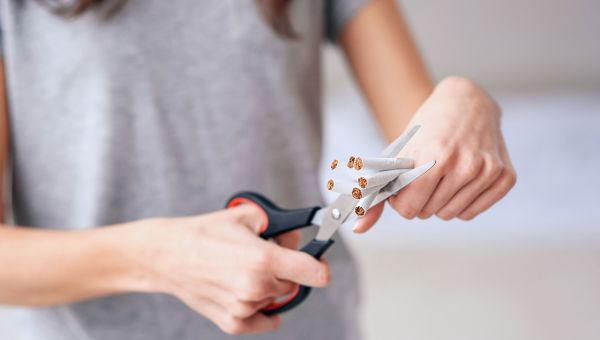How to quit smoking once and for all
Say farewell to your cigarettes by sticking with this step-by-step plan.
Updated on October 29, 2024

Quitting tobacco is one of the most important decisions a person can make. Each year, more than 480,000 people in the United States die from smoking or exposure to secondhand smoke. Another 16 million live with a smoking-related illness. By quitting, you are making the choice to live a longer, healthier life. But it’s important to be prepared.
If you’re ready to say… Show More
Quitting tobacco is one of the most important decisions a person can make. Each year, more than 480,000 people in the United States die from smoking or exposure to secondhand smoke. Another 16 million live with a smoking-related illness. By quitting, you are making the choice to live a longer, healthier life. But it’s important to be prepared.
If you’re ready to say goodbye to cigarettes, follow this plan to prepare to be smoke-free.
Show Less
Pick a quit day
Establishing a Quit Day provides a concrete timeline and allows you to plan. When picking a date, consider where you smoke and who you smoke with. If you work with tobacco users, pick a weekend date or even think about taking a few days off. If you live with a fellow tobacco user, try establishing… Show More
Establishing a Quit Day provides a concrete timeline and allows you to plan. When picking a date, consider where you smoke and who you smoke with. If you work with tobacco users, pick a weekend date or even think about taking a few days off. If you live with a fellow tobacco user, try establishing your Quit Day at the start of the work week. And consider asking them to quit with you.
Pick a date less than a month away. Around two weeks is ideal, since it’s hard to stay motivated and focused on quitting for a longer period. This gives you time to see your healthcare provider (HCP) and pick up any quit aids you might use.
Show Less
14 days until Quit Day
Start to prepare for your Quit Day. Visit your HCP to discuss your plan. If you are using a quit aid, you may need to start taking it one to two weeks before you quit, depending on which type you chose. Your HCP can discuss whether over-the-counter quit aids (like nicotine gum, patches, or lozenges)… Show More
Start to prepare for your Quit Day. Visit your HCP to discuss your plan. If you are using a quit aid, you may need to start taking it one to two weeks before you quit, depending on which type you chose. Your HCP can discuss whether over-the-counter quit aids (like nicotine gum, patches, or lozenges) or prescription quit aids are the right options for you.
Prescription quit aids, such as varenicline and bupropion, are started before your Quit Day. Follow your HCP’s advice. Sometimes, the nicotine patch is also started before your Quit Day, but only with your HCP’s guidance based on the amount you are smoking and a schedule for tapering your cigarettes.
Take some time to write down your top three reasons for quitting. Post them somewhere that is easily accessible, like your desk at work or on your bathroom mirror. Type them on your phone to keep your reasons with you at all times. Look at them when you need encouragement and motivation.
Show Less
12 Days until quit day
Certain actions, settings, and routines may trigger you to crave a cigarette. Start keeping a journal now so you can figure out what your smoking triggers are, and what changes you can make. Knowing your triggers before you quit, and how to change your habits, will help set you up for success.
Do… Show More
Certain actions, settings, and routines may trigger you to crave a cigarette. Start keeping a journal now so you can figure out what your smoking triggers are, and what changes you can make. Knowing your triggers before you quit, and how to change your habits, will help set you up for success.
Do you have a cigarette with your morning coffee? Try a different routine instead. Have your brew at a coffee shop. Call or text a friend. Read the newspaper or sign up to receive an email newsletter to start your day. Cutting back on caffeine may also be wise, as a lack of nicotine in your body will sharpen the effects of caffeine.
Maybe you smoke in the car? Take new routes to your destinations and don’t pass the stores where you purchased cigarettes. Go for a walk during what would have been your smoke break. Finally, if alcohol is a smoking trigger, consider abstaining until you feel confident in your ability to quit.
Show Less
10 days until Quit Day
Spend some time thinking about your smoke-free life. Benefits may include more money in your pockets, no smoker’s cough, and fresh-smelling clothes. It will be like a new, improved you.
Remind yourself about how happy your friends and loved ones will be, as well. Keeping them from secondhand smoke… Show More
Spend some time thinking about your smoke-free life. Benefits may include more money in your pockets, no smoker’s cough, and fresh-smelling clothes. It will be like a new, improved you.
Remind yourself about how happy your friends and loved ones will be, as well. Keeping them from secondhand smoke can add years to their lives. Even pets benefit greatly from a smoke-free environment.
In addition to good thoughts, make sure you have all your quit aids ready, too. Read all the instructions so you know exactly how to use them.
Show Less
7 days until Quit Day
Having people to lean on makes a big difference when you are trying to quit smoking. Tell your loved ones, friends, and coworkers that you are planning to quit—and ask for their help. Give them specific ways they can support you, whether it’s being available to talk, spending work breaks together,… Show More
Having people to lean on makes a big difference when you are trying to quit smoking. Tell your loved ones, friends, and coworkers that you are planning to quit—and ask for their help. Give them specific ways they can support you, whether it’s being available to talk, spending work breaks together, or trying a new activity with you.
Write down all of your plans—medications, triggers, and the names of people you have asked for support. Journaling your progress is a great outlet for any quitting-related stress you might feel.
Show Less
3 days until Quit Day
To keep your mouth and hands busy while you quit, it’s time to stock up on healthy snacks and other items. Cigarette substitutes do work—you just have to be smart about using them. Research has shown that smokers who eat more servings of fruits and vegetables have a higher quit rate than those who… Show More
To keep your mouth and hands busy while you quit, it’s time to stock up on healthy snacks and other items. Cigarette substitutes do work—you just have to be smart about using them. Research has shown that smokers who eat more servings of fruits and vegetables have a higher quit rate than those who eat fewer.
Try carrot and celery sticks, sunflower seeds, apple slices, or sugar-free gum, candy, or lollipops. Even chewing on a toothpick may help. While you’re at the grocery store, pick up a book of crossword puzzles or Sudoku, so you have another activity to occupy your hands. Alternatively, you can download a new game app to your phone.
Show Less
1 day until Quit Day
Prepare your house and your car for Quit Day. Throw out cigarettes, cigarette butts, ashtrays, lighters, matches, and any other smoking paraphernalia. Remember all the places you like to stash cigarettes, like coat pockets, old purses, or your glove compartment. It’s important that not a single… Show More
Prepare your house and your car for Quit Day. Throw out cigarettes, cigarette butts, ashtrays, lighters, matches, and any other smoking paraphernalia. Remember all the places you like to stash cigarettes, like coat pockets, old purses, or your glove compartment. It’s important that not a single cigarette be available to you.
Make sure you have all of your quit aids ready to go. Throw some in your car or bag; just to be sure you always have them with you. Ask any smokers in your life to refrain from lighting up around you. Some people even find that writing a “farewell to smoking” letter helps.
Whatever you do, don’t reach for an e-cigarette. They have not been proven to be effective quit aids. In fact, many people end up becoming dual users, meaning they continue to smoke cigarettes while also vaping.
Show Less
Quit Day
Congrats! It’s the big day! You’ve committed to living a smoke-free life. Be sure to use your quit aids according to their directions. Try out some of your smoking substitutes to keep your mouth busy. If a craving hits, drink a big glass of water, take a walk, practice deep breathing, look up your… Show More
Congrats! It’s the big day! You’ve committed to living a smoke-free life. Be sure to use your quit aids according to their directions. Try out some of your smoking substitutes to keep your mouth busy. If a craving hits, drink a big glass of water, take a walk, practice deep breathing, look up your favorite funny memes, play a game on your phone, or call a friend. Basically, try anything to distract yourself. It may take some trial and error to figure out what method works the best for you.
Show Less
The first smoke-free weeks
The first two weeks after quitting are the toughest. It’s important to stay motivated and try all of your coping techniques. It's okay if you don't feel like yourself right now or have trouble concentrating. You're still getting used to being smoke-free. Are you exercising, eating right, and… Show More
The first two weeks after quitting are the toughest. It’s important to stay motivated and try all of your coping techniques. It's okay if you don't feel like yourself right now or have trouble concentrating. You're still getting used to being smoke-free. Are you exercising, eating right, and getting enough sleep? Watch your consumption of caffeine as it might make you more jittery now.
Curb those cravings by munching on your healthy snacks. Try some non-food related distractions, too. Keep your hands and mind busy. Squeeze a stress ball, putty, or gripper. Schedule a new exercise or yoga class. When you feel a craving, take a deep breath and remind yourself it’s a physical distraction, not a command to light up. The urge to smoke will pass in minutes, and each time you resist, you get stronger.
Don’t forget your friends and loved ones, either. Ask them to help keep you busy and plan a few active smoke-free adventures with them. If you go walking with friends, seek out parks that are smoke-free.
If you have a slip and smoke a cigarette, don’t give up completely. Continue using your quit medication. Recommit to your quit plan and forge ahead!
Show Less
After two weeks
You’ve made it through the hardest time. Your cravings should be improving and you will no longer need or want to have cigarettes in your life. Share your success with your support team and focus on your accomplishment. Do something to reward yourself—you deserve it!
Quitting benefits your body and… Show More
You’ve made it through the hardest time. Your cravings should be improving and you will no longer need or want to have cigarettes in your life. Share your success with your support team and focus on your accomplishment. Do something to reward yourself—you deserve it!
Quitting benefits your body and your bank account. How much money have you saved already? Keep that money in a safe spot and think about better uses for it instead of cigarettes.
Be sure you continue your medication plan to the end. It can take brain receptors more than two months to get over nicotine cravings. Be vigilant on special occasions, during sudden heartbreak or loss, and through major life changes, as well.
Keep with it and enjoy the benefits of your new, cigarette-free life.
Show Less
U.S. Department of Health and Human Services. Smoking Cessation: A Report of the Surgeon General. Atlanta, GA: U.S. Department of Health and Human Services, Centers for Disease Control and Prevention, National Center for Chronic Disease Prevention and Health Promotion, Office on Smoking and Health; 2020.
U.S. Food & Drug Administration. Want to Quit Smoking? FDA-Approved Products and FDA-Cleared Cessation Products Can Help. Content current as of July 21, 2022.
Centers for Disease Control and Prevention. Fast Facts: Smoking and Tobacco Use. Last reviewed August 22, 2022.
More On


video

article

slideshow


video


video
